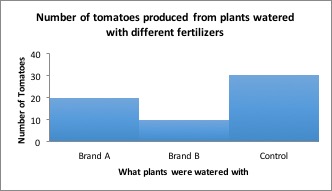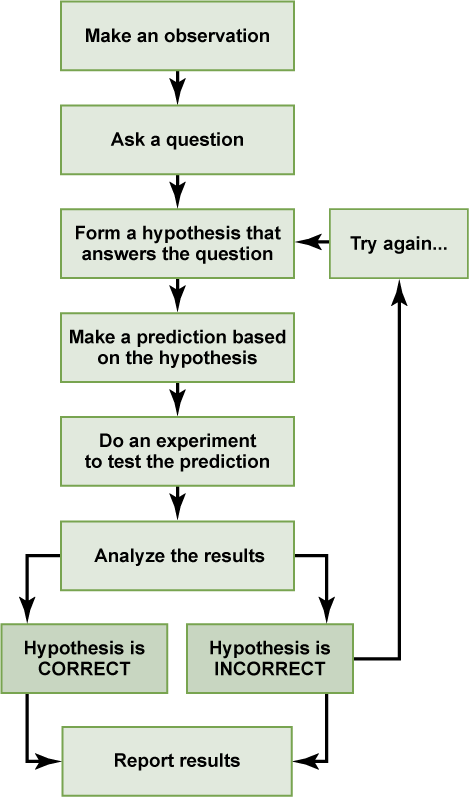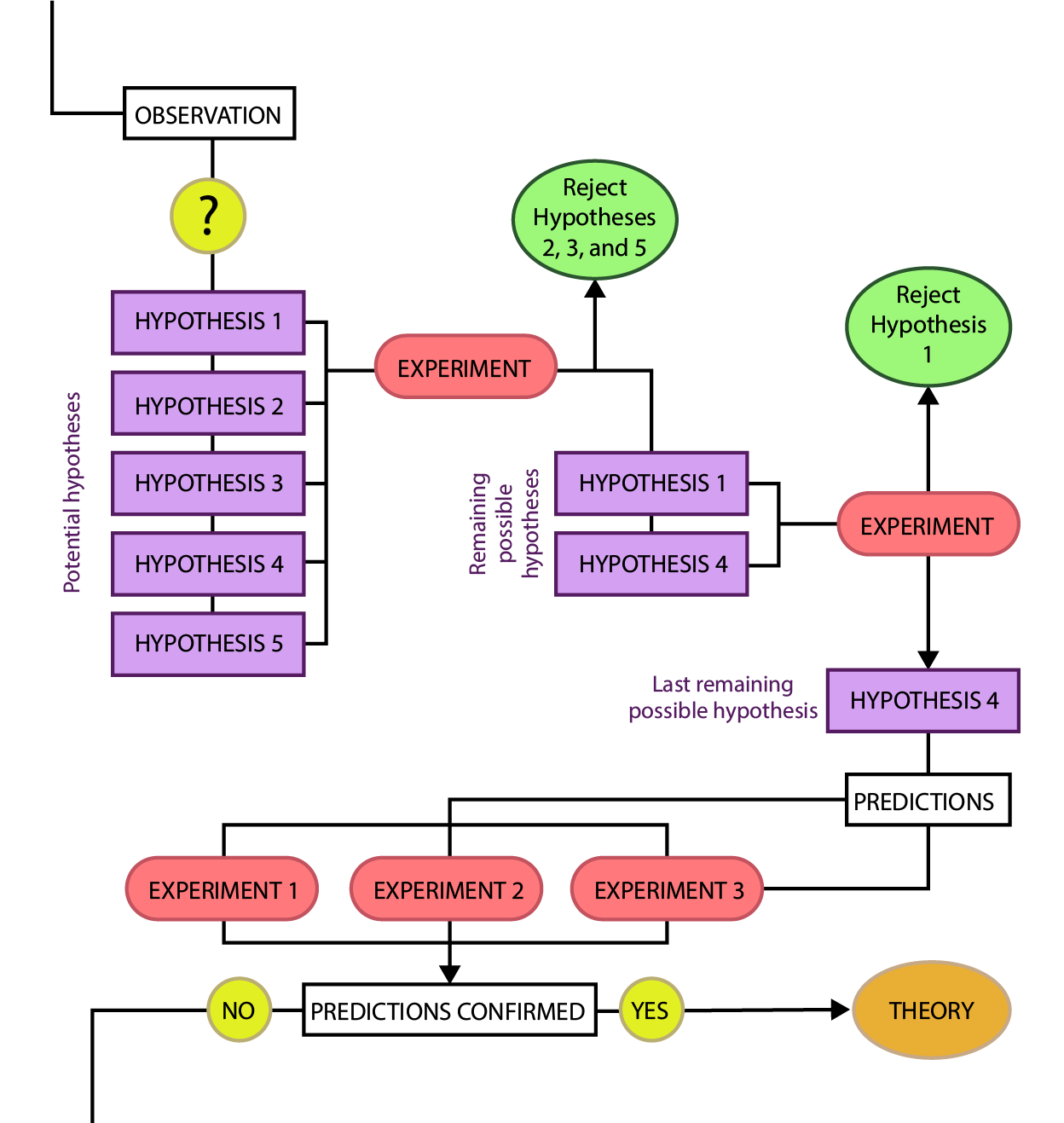1.2 The Scientific Process

Biologists study the living world by posing questions about it and seeking science-based responses. This approach is also common to other sciences and is often called the scientific method. The scientific process was used even in ancient times, but it was first documented by England’s Sir Francis Bacon (1561–1626) (Figure 1.2.1). Biologists do not exclusively use the scientific method, but it can be applied to almost anything as a logical problem-solving method.
Question
The scientific process typically starts with an observation (often a problem to be solved) that leads to a question. Remember that science is very good at answering questions about the natural world but is by definition unable to answer questions about morals (what is right or wrong to do in a situation), aesthetics (what is beautiful or ugly), or spiritual matters (Do angels exist?). Scientific information can certainly influence the search for answers to these questions, but they are outside of the definition and scope of science alone.
|
Questions that can be answered using science |
Questions that cannot be answered using science |
|---|---|
| What is the optimum temperature for the growth of E. coli bacteria? | How tall is Santa Claus? |
| Do birds prefer bird feeders of a specific colour? | Do angels exist? |
| What is the cause of this disease? | Which is better: classical music or rock and roll? |
| How effective is this drug in treating this disease? | What are the ethical implications of human cloning? |
Let’s think about a simple problem that starts with an observation and applies the scientific method to solve the problem. Imagine that one morning, when you wake up and flip a switch to turn on your bedside lamp, the light won’t turn on. That observation also describes a problem: the lights won’t turn on. Of course, you would next ask, “Why won’t the light turn on?”
Hypothesis
Recall that a hypothesis is a suggested explanation that can be tested. A hypothesis is NOT the question you are trying to answer – it is what you think the answer to the question will be and why. To solve a problem, several hypotheses may be proposed. For example, one hypothesis might be, “The light won’t turn on because the bulb is burned out.” However, there could be other answers to the question, so that other hypotheses may be proposed. A second hypothesis might be, “The light won’t turn on because the lamp is unplugged” or “The light won’t turn on because the power is out.” A hypothesis should be based on credible background information. A hypothesis is NOT just a guess (not even an educated one), although it can be based on your prior experience (such as in the example where the light won’t turn on). In general, hypotheses in biology should be based on a credible, referenced source of information.
A scientific hypothesis must be testable and falsifiable to be considered valid. Testable means that there must be a way to design an experiment or collect data to evaluate the hypothesis. Falsifiable means that the hypothesis can be shown to be false through evidence. For example, the statement “Red is a better colour than blue” is neither testable nor falsifiable because it is based on personal preference, not measurable evidence. Similarly, the hypothesis “Ghosts visit famous landmarks” is not testable or falsifiable because it involves supernatural claims that cannot be evaluated using scientific methods. Scientists test hypotheses by conducting experiments designed to eliminate or disprove them. It’s important to understand that a hypothesis can be supported by evidence, but it can never be proven. If an experiment fails to disprove a hypothesis, the hypothesis is considered supported – for now. However, future experiments or new evidence may lead to its rejection or refinement. This ongoing process is a key part of how science advances.
Experiments
Once you have identified a hypothesis, the next step is to design an experiment that will test this hypothesis. There are several important factors to consider when designing a scientific experiment.
First, scientific experiments should only test one variable, and all the other conditions are held constant. A variable is any part of the experiment that can vary or change during the experiment. By only adjusting one variable it allows researchers to isolate the effects of the variable being tested and determine its impact on the outcome.
- The independent variable is the variable that the researcher manipulates or changes in an experiment.
- The dependent variable is what the researcher measures in the experiment. It is the outcome that may change in response to the independent variable.
- A constant is a condition that is the same between all tested groups.
- A confounding variable is a condition that is not held constant that could affect the experimental results.
Hypotheses and predictions often tie in these variables:
“If [I change the independent variable in this way], then [I will observe that the dependent variable does this] because [of some reason].”
For example, the first hypothesis might be, “The light won’t turn on because the bulb is burned out.” The prediction would be, “If I change the light bulb, then the light will turn on because the bulb is burned out.” In this experiment, the independent variable (the thing that you are testing) would be changing the light bulb, and the dependent variable is whether or not the light turns on. It would be essential to keep all the other aspects of the environment constant, for example, not messing with the lamp cord or trying to turn the lamp on using a different light switch. If the entire house had lost power during the experiment because a car hit the power pole, that would be a confounding variable.
Let’s review variables by choosing the best response for the questions below.
Exercise 1.2.1
Text Description
- Seed germination
- pH
2. A scientist is testing the effect of temperature on the speed at which apples turn brown. What is the dependent variable?
- Temperature
- Speed the apple turns brown
- pH
- Type of fruit
3. You are testing whether there are more living organisms in water that comes from ponds or from rivers. What is the independent variable?
- Type of organism
- Temperature of water
- Number of living organisms
- Where the water came from
Answers:
1. pH
2. Speed the apple turns brown
3. Source of the water
Another important aspect of designing an experiment is to use experimental and control groups. The experimental group is the group in which the independent variable is changed, while the control group remains unchanged to serve as a baseline for comparison. The control group is not treated with the independent variable but is otherwise treated the same way as your experimental sample. Control groups help you to confirm that differences between your experimental groups are due to your independent variable rather than a different variable – they eliminate alternate explanations for your results (including experimental error and experimenter bias).
The following study shows the importance of using a control group.
Effectiveness of Different Fertilizer Brands
Question
Which fertilizer will produce the greatest number of tomatoes when applied to the plants?
Prediction and Hypothesis
If I apply different fertilizer brands to tomato plants, most tomatoes will be produced from plants watered with Brand A because Brand A advertises that it produces twice as many tomatoes as other leading brands.
Experiment
Purchase 10 tomato plants of the same type from the same nursery. Pick plants that are similar in size and age. Divide the plants into two groups of 5. Apply Brand A to the first group and Brand B to the second group according to the package instructions. After 10 weeks, count the number of tomatoes on each plant.
Independent Variable
Brand of fertilizer.
Dependent Variable
Number of tomatoes.
The number of tomatoes produced depends on the brand of fertilizer applied to the plants.
Constants
amount of water, type of soil, size of pot, amount of light, type of tomato plant, and length of time plants were grown.
Confounding variables
any of the above that are not held constant, plant health, diseases present in the soil or plant before it was purchased.
Results
Tomatoes fertilized with Brand A produced an average of 20 tomatoes per plant, while tomatoes fertilized with Brand B produced an average of 10 tomatoes per plant.
You’d want to use Brand A next time you grow tomatoes, right? But what if I told you that plants grown without fertilizer produced an average of 30 tomatoes per plant! Now, what will you use on your tomatoes?
graph
Results including a control group
Tomatoes which received no fertilizer produced more tomatoes than either brand of fertilizer.

Conclusion
Although Brand A fertilizer produced more tomatoes than Brand B, neither fertilizer should be used because plants grown without fertilizer produced the most tomatoes!
At the beginning of the COVID-19 pandemic, there were many questions. What is causing the illness? How is it spread? How can we stop it from spreading? Do masks work? Do vaccines work? Scientists worldwide were completing experiments to try to answer these questions.
In this study, researchers used a machine to simulate coughs and visualize the effectiveness of different masks. They connected a mannequin’s head to a fog machine to expel vapour droplets and used a green laser sheet to visualize them. In this study, the control group would be the mannequin expelling droplets without any mask. The experimental groups would be the mannequins wearing different types of masks, such as single-layer bandanas, homemade two-layer cotton masks, and 3-ply surgical masks. This setup allows researchers to compare the effectiveness of each mask type against the baseline of no mask.
When vaccines were developed to prevent COVID-19, experiments, more specifically trials, needed to be done to determine their effectiveness at preventing disease. A drug trial is a formal process of testing a new treatment or product to evaluate its effectiveness.
In COVID-19 vaccine trials, participants were divided into two groups. One group received the actual vaccine, while the other group received a placebo. A placebo is a harmless substance that looks like the vaccine but has no active ingredients (e.g. saline solution, which is a harmless saltwater injection). The purpose of the placebo is to serve as a control to compare against the effects of the actual vaccine. By comparing the rates of COVID-19 in the control and experimental groups, researchers were able to determine the effectiveness of preventing disease.
Another important aspect of designing an experiment is to consider blinding techniques, such as single-blind (where only participants are unaware of group assignments) and double-blind (where both participants and researchers are unaware), to reduce bias.
Most vaccine trials follow a double-blind design where neither the participants nor the researchers know who is receiving the vaccine and who is receiving the placebo. This design helps eliminate bias and ensures that the expectations of either the participants or the researchers do not influence the results. For example, if participants knew they were receiving the placebo, they might behave differently or report symptoms differently than those receiving the vaccine. Similarly, if researchers knew who received the vaccine, they might unconsciously interpret the results in a biased way.
Results
Your experiment’s results are the data you collect as the outcome. In the light experiment, your results are either that the light turns on or doesn’t turn on. Based on your results, you can conclude. Your conclusion uses the results to answer your original question.

Figure 1.2.3 Description
The Scientific Method process consists of a series of steps connected by arrows, showing how scientists approach problem-solving and experimentation. 1. Make an Observation, 2. Ask a Question, 3. Form a Hypothesis That Answers the Question, 4. Make a Prediction Based on the Hypothesis, 5. Do an Experiment to Test the Prediction, 6. Analyze the Result, 7. Ask: Was the Hypothesis Correct? If correct, the flow continues downward to Report Results (Final step if Hypothesis is Correct). If incorrect, an arrow leads to the side with a box labelled “Hypothesis is INCORRECT” and directs back to Form a Hypothesis That Answers the Question to revise and try again.
In practice, the scientific method is not as rigid and structured as it might initially appear. Sometimes, an experiment leads to conclusions that favour a change in approach; often, an experiment brings entirely new scientific questions to the puzzle. Science usually does not operate linearly; scientists continually draw inferences and make generalizations, finding patterns as their research proceeds. Scientific reasoning is more complex than the scientific method alone suggests.

Figure 1.2.4 Description
The image is a complex flowchart that illustrates that scientific reasoning is actually more intricate than the traditional linear model suggests. Multiple interconnected boxes represent the various steps of the scientific process, with arrows pointing in various directions, indicating that the process is non-linear and often involves feedback loops, revisits, and adjustments. Arrows loop back from conclusions to earlier steps like hypothesis formation, experimentation, and even observation, showing that scientists often revisit and refine previous steps. Multiple pathways connect the steps, emphasizing that scientific investigation is rarely a straightforward process.
Let’s put the scientific method into practice. Drag each item to its corresponding step in the process.
Exercise 1.2.2
Text Description
- My toaster doesn’t toast my bread.
- If something is wrong with the outlet, my coffeemaker also won’t work when plugged into it.
- I plug my coffeemaker into the outlet.
- My coffeemaker works.
- Why doesn’t my toaster work?
- There is something wrong with the electrical outlet.
Answers:
- Observation: My toaster doesn’t toast my bread.
- Question: Why doesn’t my toaster work?
- Hypothesis: There is something wrong with the electrical outlet.
- Prediction: If something is wrong with the outlet, my coffeemaker also won’t work when plugged into it.
- Experiment: I plug my coffeemaker into the outlet.
- Results: My coffeemaker works.
Reporting Scientific Work
Whether scientific research is basic science or applied science, scientists must share their findings for other researchers to expand and build upon their discoveries. Communication and collaboration within and between science sub-disciplines are key to advancing knowledge in science. For this reason, an essential aspect of a scientist’s work is disseminating results and communicating with peers. Scientists can share results by presenting them at a scientific meeting or conference, but this approach can reach only the few scientists that are present. Instead, most scientists present their results in peer-reviewed articles published in scientific journals. Peer-reviewed articles are scientific papers that are reviewed, usually anonymously, by a scientist’s colleagues or peers. These colleagues are qualified individuals, often experts in the same research area, who judge whether or not the scientist’s work is suitable for publication. The peer review process helps ensure that the research described in a scientific paper or is original, significant, logical, and thorough. Scientists publish their work so other scientists can reproduce their experiments under similar or different conditions to expand on the findings. The experimental results must be consistent with the findings of other scientists.
Many journals and the popular press do not use a peer-review system. Many online open-access journals, with articles available without cost, are now available, many of which use rigorous peer-review systems, but some do not. The results of any studies published in these forums without peer review are unreliable and should not form the basis for other scientific work.
“The Scientific Process” from Principles of Biology by Catherine Creech is licensed under a Creative Commons Attribution 4.0 International License, except where otherwise noted.
“1.2 The Process of Science” from Biology and the Citizen by Colleen Jones is licensed under a Creative Commons Attribution 4.0 International License, except where otherwise noted.

